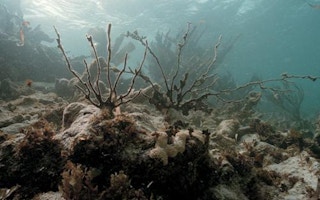The cost of damage to the world’s oceans from climate change could reach $2 trillion a year by 2100 if measures to cut greenhouse gas emissions are not stepped up, a study by marine experts said on Wednesday.
The study found that without action to limit rising greenhouse gas emissions, the global average temperature could rise by 4 degrees Celsius by the end of the century causing ocean acidification, sea level rise, marine pollution, species migration and more intense tropical cyclones. It would also threaten coral reefs, disrupt fisheries and deplete fish stocks.
In the study, “Valuing the Ocean”, marine experts led by the Stockholm Environment Institute (SEI) analysed the most severe threats facing the world’s marine environment and estimated the cost of damage from global warming.
It found nitrogen-rich fertilisers and waste would strip more ocean areas of oxygen, causing what is known as hypoxic dead zones, which are already found in more than 500 locations.
“By 2100, the cost of damage if we do not radically cut emissions rises to $1.98 trillion, or 0.37 percent of global gross domestic product,” the SEI said.
The loss of tourism would incur the highest cost at $639 billion per year. The loss of the ocean carbon sink, the seas’ ability to soak up carbon dioxide (CO2), would cost almost $458 billion, the study showed. Warmer water holds less CO2.
Radical technologies
If cuts in emissions of planet-warming greenhouse gases were carried out more urgently and temperature increases were limited to 2.2 degrees C, nearly $1.4 trillion of the total cost could be avoided, the study found.
However, such progress would require the widespread use of radical carbon removal technologies like sucking carbon dioxide out of the atmosphere, Frank Ackerman, one of the report’s authors told Reuters.
“The faster we stop emissions rising, the lower the damage will be. But on current technology, I wouldn’t be surprised if we end up on a 4 degree C pathway,” said Ackerman, senior economist and director of the Climate Economics Group at SEI’s US Center.
The study did not put a monetary value on the loss of some species which inhabit the world’s oceans, critical processes like nutrient cycling or the loss of coastal communities’ traditional ways of life.
“The challenge is to figure out what parts of the ocean environment have a value you can put a meaningful price on. There are very important areas which we still can’t incorporate into a market,” Ackerman said.
The study also recommended that the United Nations appoints a High Commissioner for Oceans to coordinate research and action, that ocean services should be more integrated into economic policy and that there should be more preparation for a 1-2 metre sea level rise by the end of the century.
A new potential market in “blue carbon” could also present an important economic opportunity, SEI said.
Marine ecosystems, like mangroves and sea grasses, contain far more carbon than terrestrial forests but are being degraded at a more alarming rate and are not yet included in carbon offset schemes, which reward investors in emissions reduction projects in developing countries with carbon credits.
“There are many questions about the legal responsibility for different parts of the ocean. Tracking terrestrial carbon offsets is enough of a challenge, tracking the marine ones is going to be a new challenge,” Ackerman said.
“But they need to be included. Leaving out an area like that could undermine progress being made in areas that are being taken care of.”










